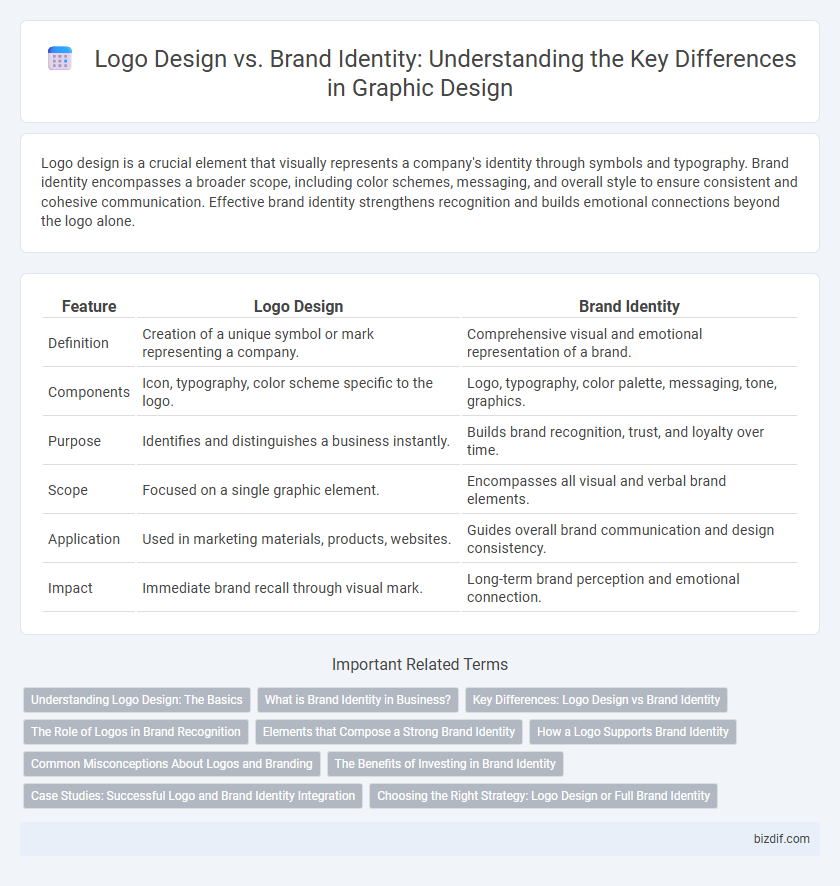Logo design is a crucial element that visually represents a company's identity through symbols and typography. Brand identity encompasses a broader scope, including color schemes, messaging, and overall style to ensure consistent and cohesive communication. Effective brand identity strengthens recognition and builds emotional connections beyond the logo alone.
Table of Comparison
| Feature | Logo Design | Brand Identity |
|---|---|---|
| Definition | Creation of a unique symbol or mark representing a company. | Comprehensive visual and emotional representation of a brand. |
| Components | Icon, typography, color scheme specific to the logo. | Logo, typography, color palette, messaging, tone, graphics. |
| Purpose | Identifies and distinguishes a business instantly. | Builds brand recognition, trust, and loyalty over time. |
| Scope | Focused on a single graphic element. | Encompasses all visual and verbal brand elements. |
| Application | Used in marketing materials, products, websites. | Guides overall brand communication and design consistency. |
| Impact | Immediate brand recall through visual mark. | Long-term brand perception and emotional connection. |
Understanding Logo Design: The Basics
Logo design involves creating a unique visual symbol that represents a brand's identity through color, shape, and typography. It serves as the foundation for brand recognition and plays a crucial role in distinguishing a company in competitive markets. Effective logo design balances simplicity with memorability to ensure instant recognition across various media platforms.
What is Brand Identity in Business?
Brand identity in business encompasses the comprehensive visual, verbal, and experiential elements that define a company's personality and values, including logo design, color schemes, typography, and messaging. It serves as the cohesive framework that shapes customer perception and builds emotional connections, ensuring consistent representation across all marketing channels and touchpoints. Effective brand identity differentiates a business in competitive markets by establishing trust, recognition, and loyalty among its target audience.
Key Differences: Logo Design vs Brand Identity
Logo design is the creation of a unique visual symbol that represents a company's name or product, focusing on simplicity and recognizability. Brand identity encompasses a broader scope, including the logo, color palette, typography, imagery, and overall style that convey a company's personality and values consistently across all platforms. Key differences lie in logo design serving as a single element for brand recognition, while brand identity shapes the comprehensive visual and emotional perception of the brand.
The Role of Logos in Brand Recognition
Logos serve as a crucial visual symbol that encapsulates a brand's identity, making them indispensable for brand recognition and recall. Effective logo design incorporates distinct colors, shapes, and typography that resonate with target audiences and differentiate the brand within competitive markets. While brand identity encompasses the broader spectrum of visual and emotional brand elements, logos provide the immediate visual anchor that fosters consumer trust and loyalty.
Elements that Compose a Strong Brand Identity
Logo design serves as a visual symbol representing a brand, while brand identity encompasses a comprehensive set of elements that create a cohesive and recognizable image. Key components of a strong brand identity include a consistent color palette, typography, imagery style, tone of voice, and design principles that align with the brand's values and mission. These elements work synergistically to establish emotional connections and foster brand loyalty beyond the scope of the logo alone.
How a Logo Supports Brand Identity
A logo serves as the visual cornerstone of brand identity by encapsulating the brand's core values and personality into a simple, memorable graphic symbol. It enhances brand recognition and consistency across marketing materials, digital platforms, and product packaging, reinforcing consumer trust and loyalty. Effective logo design leverages color psychology, typography, and unique iconography to create an immediate emotional connection, supporting the broader strategic narrative of the brand identity.
Common Misconceptions About Logos and Branding
Logo design is often mistaken as the entirety of brand identity, but a logo is just a single visual element within a broader, multifaceted brand strategy that includes tone, messaging, and customer experience. Many businesses underestimate the importance of consistent brand identity, which extends beyond a logo to build emotional connections and brand loyalty. Understanding that brand identity encompasses visual, verbal, and experiential elements helps avoid the misconception that a logo alone can establish a company's market presence.
The Benefits of Investing in Brand Identity
Investing in brand identity offers comprehensive benefits beyond logo design by establishing a cohesive visual language, voice, and emotional connection with the target audience. A strong brand identity enhances recognition, builds trust, and differentiates a company in competitive markets, driving long-term customer loyalty and business growth. This strategic approach integrates consistent messaging across all platforms, ensuring unified brand perception and increased market value.
Case Studies: Successful Logo and Brand Identity Integration
Case studies of successful logo and brand identity integration reveal how visual consistency drives brand recognition and customer loyalty. Companies like Apple and Coca-Cola demonstrate cohesive use of logo design elements across marketing materials to reinforce brand values and emotional connections. These examples underscore the importance of harmonizing logo aesthetics with broader brand messaging for impactful visual storytelling.
Choosing the Right Strategy: Logo Design or Full Brand Identity
Selecting between logo design and a full brand identity depends on business goals and target audience. A logo serves as a visual symbol for quick recognition, while brand identity encompasses a cohesive system including color palettes, typography, and messaging to convey the brand's personality. Investing in comprehensive brand identity development enhances consistency across marketing channels and builds stronger emotional connections with customers.
Logo design vs Brand identity Infographic

 bizdif.com
bizdif.com